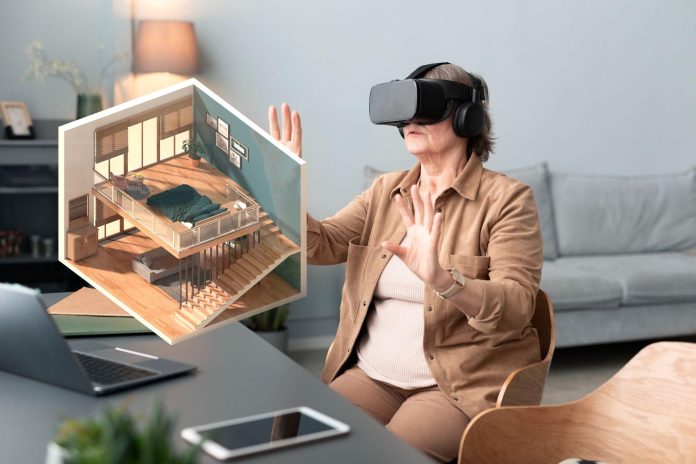
In the realm of interior design, the boundaries of creativity and innovation have expanded dramatically with the integration of technology. Augmented Reality (AR) and Virtual Reality (VR) are two technological marvels that have emerged as powerful tools, revolutionizing the way designers conceptualize, communicate, and execute their ideas. These immersive technologies have transcended traditional design processes, offering a dynamic and interactive approach that enhances collaboration, visualization, and decision-making. In this article, we delve into the pivotal role that AR and VR play in modern interior design, exploring their manifold benefits and the endless possibilities they offer to both designers and clients.
Visualization Redefined
One of the most significant challenges in interior design has been translating abstract ideas into tangible visualizations for clients. AR and VR address this issue head-on, providing unprecedented means to visualize concepts. VR immerses clients in a fully simulated environment where they can explore every corner of a design, effectively bridging the gap between imagination and reality. AR overlays digital elements onto the physical space, allowing clients to visualize how furniture, colors, and textures blend with their existing surroundings. By offering realistic and immersive experiences, these technologies empower clients to make informed decisions, reduce misunderstandings, and enhance client-designer collaboration.
Design Iteration and Flexibility

Traditional design processes often involve countless revisions, which can be time-consuming and costly. AR and VR streamline this aspect by enabling rapid design iterations and adjustments. Designers can create virtual prototypes of their concepts and assess their impact in real time. Changes in color schemes, furniture arrangements, or lighting can be implemented instantly, providing immediate feedback on the design’s viability. This agility not only accelerates the design process but also empowers designers to experiment with unconventional ideas without the risk of costly mistakes, ultimately resulting in more innovative and refined interior spaces.
Enhanced Communication
Clear communication is the cornerstone of successful interior design projects. AR and VR enhance communication by providing a shared visual language that eliminates misunderstandings. Designers can present their ideas more effectively, allowing clients to experience the proposed design rather than merely envision it. Moreover, collaborative design sessions in virtual spaces enable stakeholders from different geographical locations to participate in real-time discussions, fostering a more inclusive and cohesive design process.

Space Planning and Functionality
Space planning is a critical aspect of interior design, ensuring optimal functionality and flow within a given space. AR and VR facilitate this process by allowing designers to create accurate 3D models of spaces and experiment with various layouts. Designers and clients can virtually walk through these spaces, gaining insights into traffic patterns, spatial relationships, and overall aesthetics. This level of immersion aids in identifying design flaws early in the process, leading to better-informed decisions and ultimately creating spaces that harmonize aesthetics and functionality.
Customization and Personalization
In the modern design landscape, personalization is key. AR and VR empower clients to visualize customizations and tailor designs to their preferences. Whether it’s adjusting furniture styles, experimenting with different materials, or altering room layouts, these technologies enable clients to actively participate in shaping their living spaces. This level of involvement fosters a deeper emotional connection between the client and the design, resulting in spaces that are not just aesthetically pleasing but also deeply meaningful.
Sustainability and Resource Efficiency

As sustainable design practices gain prominence, AR and VR offer tools to minimize waste and resource consumption. Designers can use these technologies to accurately assess the impact of various materials and finishes on a space’s energy efficiency and environmental footprint. This knowledge empowers designers to make informed choices that align with sustainability goals, contributing to the overall well-being of both occupants and the environment.
Bridging the Gap Between Imagination and Reality
Perhaps the most remarkable contribution of AR and VR to modern interior design is their ability to bridge the gap between imagination and reality. These technologies allow designers to create dream-like, surreal environments that were once confined to the realm of sketches and conceptual drawings. Designers can now take clients on journeys through spaces that transcend the ordinary, enabling them to experience designs that are otherwise hard to imagine. This immersive experience fosters a deep emotional connection to the design, enhancing its impact and significance.

In the dynamic world of interior design, the integration of Augmented Reality and Virtual Reality has ushered in a new era of creativity, efficiency, and collaboration. These technologies have transformed the way designers conceptualize, communicate, and execute their ideas, offering benefits that extend far beyond aesthetics. From enhancing visualization and communication to facilitating sustainable practices and enabling unprecedented personalization, AR and VR have proven to be indispensable tools in the modern designer’s toolkit. As these technologies continue to evolve, the possibilities for innovation in interior design become limitless. Embracing AR and VR not only propels the field forward but also enriches the lives of clients by bringing their design dreams to life in ways they never thought possible.
